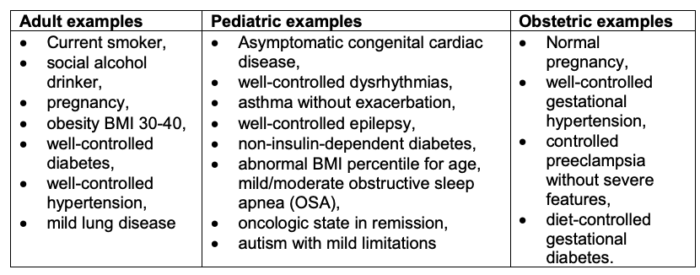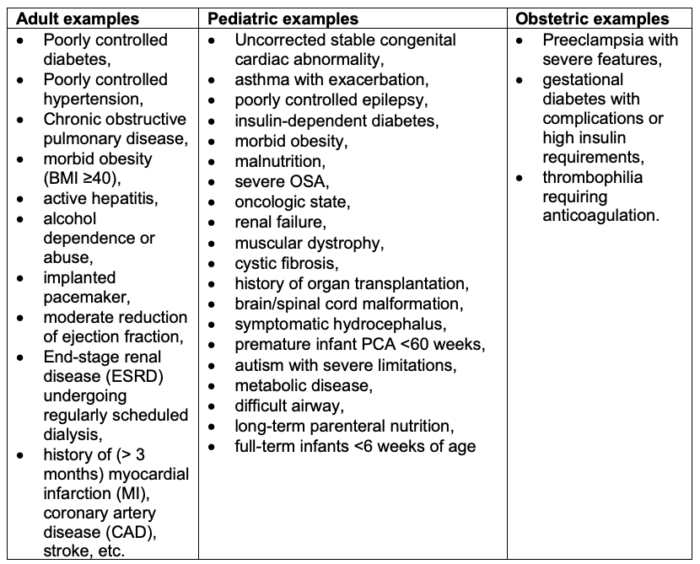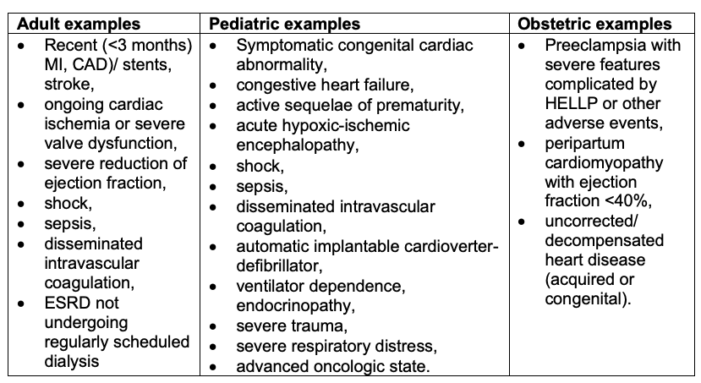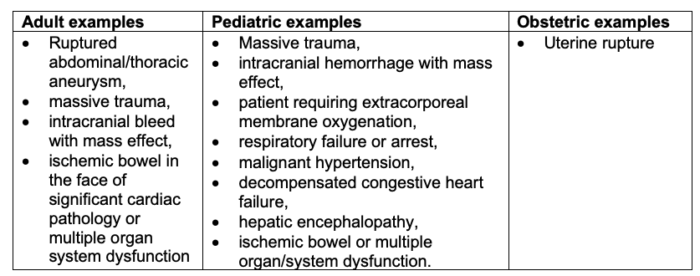Copy link
ASA Physical Status Classification
Last updated: 01/12/2024
Key Points
- The American Society of Anesthesiologists (ASA) physical status (PS) classification system is an easy-to-use system to assess a patient’s preoperative physical condition. It includes six levels ranging from I (healthy patient) to VI (brain-dead organ donor) with an emergency modification (E) for levels I to V.
- When used alone, the ASA PS classification system has limited value as a risk prediction tool for the individual patient.
- There is a continuing need to improve interrater reliability.
Introduction
- The ASA PS classification system allows effortless and rapid assignment of a class to a patient ranging from I to VI based on their physical status and comorbidities (Table 1).1,2
- “E” denotes emergency, which is defined as existing when a delay in treatment of the patient would lead to a significant increase in the threat to life or body part.1,2
- The examples listed in the tables below are from references 1 and 2.
ASA I

Table 1. ASA I. A healthy patient without organic, biochemical, or psychiatric disease1,2
ASA II
- Although pregnancy is not a disease, a pregnant patient’s physiological state is significantly altered from the nonpregnant state. Hence, the ASA II designation for an uncomplicated pregnancy.

Table 2. ASA II. A patient with mild systemic disease without functional limitations1,2
ASA III

Table 3. ASA III. A patient with severe systemic disease with substantial functional limitations1,2
ASA IV

Table 4. ASA IV. A patient with severe systemic disease that is a constant threat to life1,2
ASA V

Table 5. ASA V. A moribund patient who is not expected to survive without the operation1,2
ASA VI
- ASA VI is a brain-dead patient whose organs are being removed for donor purposes.1,2
History and Evolution
- The first version of a physical status classification system was introduced by Saklad, Taylor, and Rovenstine in 1941 and served as the basis for the contemporary ASA PS classification system.3 The original intent was “to study, examine, experiment, and devise a system for the collection and tabulation of statistical data in anesthesia.”3
- In 1961, Dripps et al. published a study in which a physical status classification was used that closely resembles the current ASA PS4 and served as the basis for its official implementation by the ASA House of Delegates in 1962.
- Since its inception, several small modifications have been made over the years.1,2 The current version offers examples for each category to support improved interrater reliability.1,2
- In the most recent 2020 update, the ASA acknowledged the unique physiology and pathology of pediatric and pregnant patients by providing examples that are specific to these patients.1,2
Optimal Utilization of ASA PS Classification
- The primary intended use of the ASA PS classification system is to summarize and compare the preoperative health status of surgical patients.2
- It is widely used as an administrative tool to compare the performance of hospitals or as a covariate for measuring the outcomes of specific surgical subpopulations.2
- It is also a universal component of clinical investigations as a parameter of the demographic characteristics of subjects to verify similarities or explain outcome differences between groups.2
- Individual anesthesiology departments may add their own consensus-based examples to supplement the ASA-approved examples to improve communication and interrater reliability within a given group of anesthesiologists.1,2
Limitations of the ASA PS Classification System
- ASA PS classification system is incorrectly used for purposes beyond the original intent.2
- Decisions regarding inpatient vs. ambulatory care for individual patients
- To determine anesthesia staffing ratios
- To decide if anesthesia professionals are required for out-of-operating room sedation
- Many insurers use it as a billing modifier.
- Another major limitation of the ASA PS classification system is interrater reliability and reproducibility.2,5,6 The level of agreement among different providers can be low when assigning ASA PS classes.2,5,6
- The addition of case examples for pediatric anesthesia patients has had mixed effects.6
- Further studies are required to evaluate the impact of the subspecialty-specific case examples on interrater reliability among pediatric and obstetric anesthesiologists.
- There is considerable ambiguity regarding the emergency designation since it does not specify the duration or severity of the emergency diagnosis.2 Similarly, there is little guidance on how to integrate the patient’s preinjury status for trauma cases, advanced life support measures for intensive care patients, or frailty in older patients.2
- The ASA PS classification system performs poorly as an operative risk predictor when used as a stand-alone tool for the individual patient since it does not consider factors like the patient’s functional capacity, frailty, surgeon/anesthesiologist experience, type of procedure, and level of postoperative care.1,2
The Future of the ASA PS System
- Potential areas for improvement depend on the intent of modifications:
- Refining the definitions of ASA II, III, and IV patients (which represent the greatest degree of assignment variability)
- Efforts to improve category clarity and interrater consistency2
- Efforts to identify those clinical scenarios that seem to result in the most common assignment discrepancies2,5
- Continuing to focus on identified “problems” might yield significant interrater reliability improvements5
- Since different providers will judge the health status of the same patient differently, even if both providers personally perform histories and physical examinations, perfect consistency when binning the enormous spectrum of human disease to ordinal data is likely unattainable.2,5
- Refining the system with the additional focus on frailty and emergency patients2
- The result of such efforts might involve a few more ASA-PS categories or further revision of patient examples.2
- Enlisting technology such as artificial intelligence, Anesthesia Information Management Systems, or other computerized cognitive aids may improve interrater reliability.2
- Semi-manual systems (e.g., a smartphone-based application or web-based algorithms) that ask a provider to answer a series of simple Yes/No questions to “recommend” an ASA-PS class designation.2
- Maintaining the system and adjusting it to the changing health care environment requires periodic re-examination, consistent with its long-standing history.2
References
- ASA Physical Status Classification System. American Society of Anesthesiologists. Developed By: ASA Committee on Economics. Accessed on May 31st, 2022. Link
- Horvath B, Kloesel B, Todd MM, et al. The evolution, current value, and future of the American Society of Anesthesiologists physical status classification system. Anesthesiology. 2021;135(5):904-19. PubMed
- Saklad M. Grading of patients for surgical procedures. Anesthesiology. 1941; 2:281-4. Link
- Dripps RD, Lamont A, Eckenhoff JE. The role of anesthesia in surgical mortality. JAMA. 1961; 178:261-6. PubMed
- Abouleish AE, Vinta SR, Shabot SM, et al. Improving agreement of ASA physical status class between pre-anesthesia screening and day of surgery by adding institutional-specific and ASA-approved examples: a quality improvement project. Perioper Med (London). 2020;9(1):1-34. PubMed
- Ferrari L, Leahy I, Staffa SJ, et al. The pediatric-specific American Society of Anesthesiologists physical status score: A Multicenter Study. Anesth Analg. 2020; 132(3):807-17. PubMed
Copyright Information

This work is licensed under a Creative Commons Attribution-NonCommercial-NoDerivatives 4.0 International License.